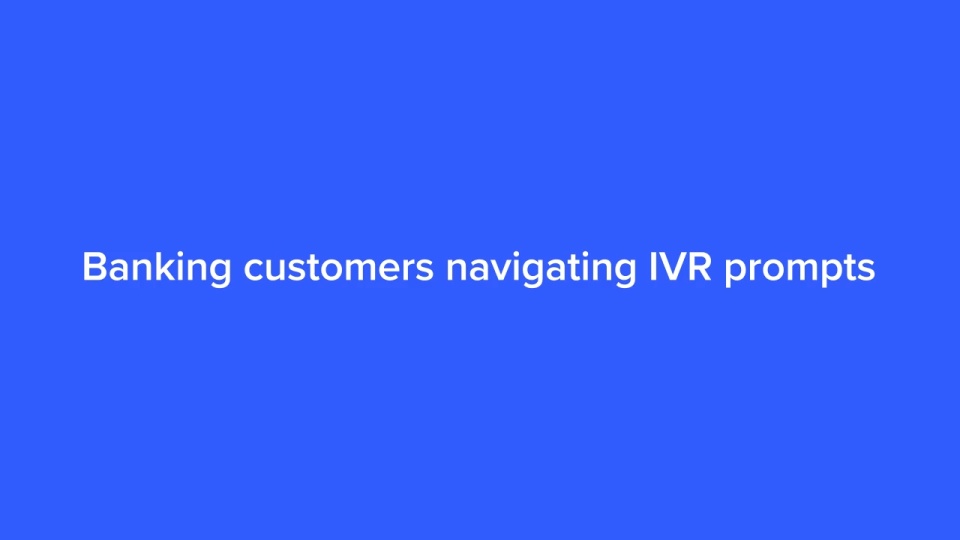
The customer experience crisis in banking contact centers—and how to fix it

“I was so frustrated, I just kept pressing zero until I got a person.”
If you've said something like this after calling your bank, you're not alone. For millions of customers, interacting with banking contact centers feels like running a marathon blindfolded: long, confusing, and exhausting. Despite years of investment in digital transformation, the customer experience in banking contact centers continues to fall short—driving up costs, increasing churn, and eroding trust.
But this crisis isn’t rooted in a lack of technology. It stems from a critical blind spot: banks don't have real visibility into the actual experiences their customers are having.
Long wait times, confusing support, and frustrated customers
Today’s banking customers expect fast, seamless, and efficient support. But when they reach out for help, they often face frustrations. According to Capgemini, major pain points include:
- Long wait times: 61% of customers expect instant digital interactions and feel frustrated when waiting for resolutions.
- Inconsistent communication: 65% of customers want clear, reliable, and unified responses, yet misaligned messaging from agents leads to confusion.
- Lack of real-time updates: 63% of customers say that not having real-time information during interactions is a major challenge.
Despite major investments in IVR systems, chatbots, and self-service tools, banking contact centers remain overwhelmed with high call volumes for routine inquiries like balance checks, fund transfers, and transaction disputes.
The result? Banking contact center experiences that are inefficient, expensive, and deeply frustrating as customers bypass self-service, leading to longer wait times, higher operational costs, and lower customer satisfaction.
“Customers don’t necessarily dislike self-service—they abandon it when it doesn’t meet their expectations.”
GUIDE
The future of banking contact centers: improving containment and self-service
In this guide, you’ll learn how to refine IVR prompts, optimize self-service, and create seamless omnichannel support that reduces operational costs without frustrating your customers.
What’s driving the breakdown in banking self-service?
Despite heavy investment in IVR systems, chatbots, and automated support, many banks still experience high call volumes for routine tasks like checking balances or disputing transactions. This suggests a deeper issue: customers aren’t opting into self-service—not because they can’t, but because they don’t trust it to work.
Banks know that increasing self-service containment (the ability to fully resolve an issue without live support) is key to lowering operational costs and boosting efficiency. But most are flying blind when it comes to understanding why customers are abandoning these tools.
Here’s what the data reveals:
70% of customers press “0” to reach a live agent when presented with IVR options—often within seconds of calling.
Only 32% of customers globally are satisfied with their bank’s contact center experience.
26% of customers who switch banks cite poor service as their primary reason for leaving.
What’s missing isn’t technology—it’s empathy and insight into the real customer experience.
Why data alone can’t fix the customer experience crisis
Most banks rely heavily on metrics like call volume, containment rates, and average handle time. But these numbers don’t tell the full story. They can’t answer crucial questions like:
- Why are customers skipping self-service tools?
- What’s causing frustration within IVR systems?
- Where exactly does the experience break down?
“Data shows what’s happening—human insight explains why.”
To move beyond surface-level fixes, banks need direct access to authentic customer feedback—real voices, real behaviors, and real reactions to real scenarios.
The emotional cost of a broken support journey
UserTesting studies have shown that customers navigating poorly designed contact center experiences report strong negative emotions: frustration, confusion, even panic. For many, these moments are tied to deeply personal matters—like resolving a payment issue or accessing funds urgently.

Customer quotes from recent feedback videos include:
- “None of the options fit what I needed, but there was no way to reach an agent.”
- “The voice recognition didn’t understand me, no matter how many times I tried.”
- “There were so many options, I forgot what I was even calling about.”
- “It’s frustrating dealing with my money and feeling like no one understands or cares.”
These experiences damage trust and drive long-term brand erosion—something banks can’t afford in today’s highly competitive financial services landscape.
From insight to impact: using human feedback to improve containment
Here’s the good news: leading banks are turning to real-time customer feedback platforms like UserTesting to unlock the human insight behind their support experiences—and drive meaningful change.
By incorporating customer perspectives into their self-service design, they can:
Pinpoint exactly where customers drop off in IVR, chatbot, and support flows
Identify messaging gaps and confusing language that lead to self-service abandonment
Test new designs and scripts before launch to ensure clarity, usability, and satisfaction
Understand emotional reactions to friction points, allowing teams to prioritize fixes that matter most
“When customers feel heard, containment goes up—and costs come down.”
This human-centered approach is essential to creating a support journey that meets customer expectations and drives digital adoption.
The ROI of customer empathy in financial services UX
Improving the user experience (UX) of self-service tools isn’t just a customer-centric move—it’s also a smart business strategy. By optimizing their digital customer journeys, banks can:
Reduce call volumes and operational costs
Increase customer service automation efficiency
Improve satisfaction and retention rates
Boost containment without compromising quality
Build trust by delivering consistent, omnichannel banking support
For example, one bank used UserTesting to identify a single word in their IVR menu that confused 40% of callers. By adjusting the language and simplifying the options, they saw a measurable increase in containment rates—and a 17% drop in support escalations.
A future-forward vision: seamless, customer-centric, and efficient
The path forward for banking contact centers isn’t more automation—it’s smarter, more empathetic automation. Customers aren’t asking for fewer digital tools. They’re asking for tools that work, that make sense, and that show the bank understands their needs.
To get there, banks must commit to embedding customer feedback into their support design process. This means:
Making regular customer insight testing part of the development cycle
Listening to real customers—across demographics, languages, and device types
Prioritizing changes that improve both usability and emotional experience
Benchmarking progress using both quantitative and qualitative measures
Transforming the banking contact center experience with customer insight
The crisis in banking contact centers is solvable—but only if institutions go beyond the data and embrace the voice of the customer. With tools like UserTesting, banks can finally understand what their customers are experiencing in real time, and use that insight to create better, faster, and more human-centered digital support.
“The future of banking support isn’t just digital—it’s empathetic.”






